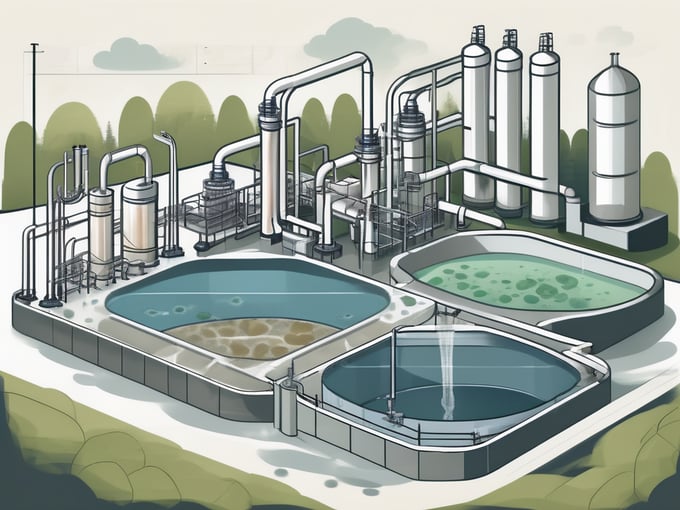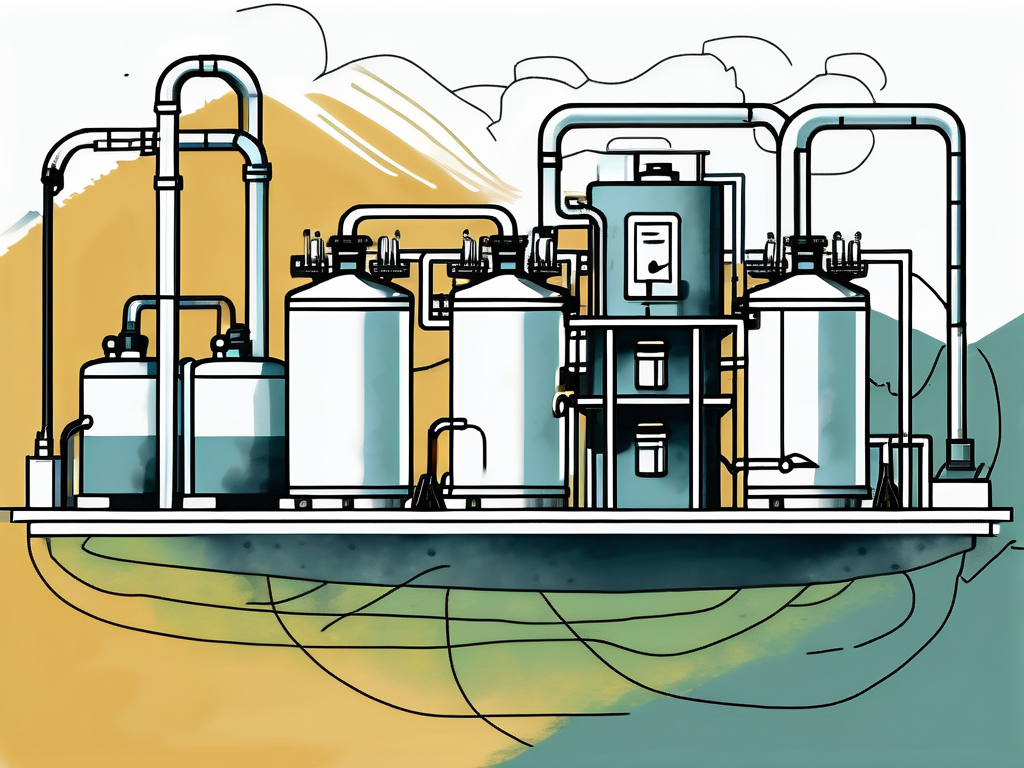
Hazardous Waste: Wastewater Treatment Explained
Wastewater treatment is a complex process that involves the removal of contaminants from wastewater, primarily from household sewage. It includes physical, chemical, and biological processes to remove these contaminants and produce environmentally safer treated wastewater (or treated effluent). A by-product of sewage treatment is usually a semi-solid waste or slurry, called sewage sludge, that has to undergo further treatment before being suitable for disposal or land application.
When it comes to hazardous waste, the treatment process becomes even more intricate. Hazardous waste is waste that poses substantial or potential threats to public health or the environment. It is a broad term that can refer to a variety of waste types, including industrial waste, chemical waste, and radioactive waste. The treatment of hazardous waste requires specialized techniques and technologies to ensure that it is handled and disposed of safely.
Understanding Hazardous Waste
Hazardous waste is a type of waste that can cause harm to humans, animals, and the environment. It can be in the form of solids, liquids, or contained gases, and it can cause damage during inadequate disposal, treatment, transportation, or storage. The characteristics that make waste hazardous are ignitability, reactivity, corrosivity, and toxicity.
These wastes can be by-products of manufacturing processes or discarded commercial products like cleaning fluids or pesticides. In the United States, the Environmental Protection Agency (EPA) and the states regulate the storage, treatment, and disposal of hazardous waste. The EPA has listed over 500 specific wastes as hazardous and has also developed categories of processes that generate hazardous wastes.
Types of Hazardous Waste
There are several types of hazardous waste, including listed wastes, characteristic wastes, universal wastes, and mixed wastes. Listed wastes are wastes that EPA has determined are hazardous. They include F-listed wastes, which are from common manufacturing and industrial processes; K-listed wastes, which are from specific industries; and P-listed and U-listed wastes, which are from commercial chemical products.
Characteristic wastes are those that do not meet any of the listings above but exhibit ignitability, corrosivity, reactivity, or toxicity. Universal wastes are consumer items that are not immediately dangerous but can cause harm over time, like batteries and fluorescent lamps. Mixed wastes contain both radioactive and hazardous waste components.
Wastewater Treatment Process
The wastewater treatment process is a series of steps designed to remove physical, chemical, and biological contaminants from wastewater. The primary goal of these processes is to produce an effluent that will do as little harm as possible when discharged to the surrounding environment, thereby preventing pollution.

The treatment of wastewater is divided into three phases: primary treatment, secondary treatment, and tertiary treatment. Primary treatment involves the removal of large particles from the wastewater. Secondary treatment involves the removal of organic matter using biological processes. Tertiary treatment involves the removal of any remaining solids, disinfection of the water, and then releasing or reusing the water.
Primary Treatment
Primary treatment is the first phase of wastewater treatment. During this phase, wastewater is placed in holding tanks where heavy solids can settle to the bottom while oil, grease, and lighter solids float to the surface. The settled and floating materials are removed and the remaining liquid may be discharged or subjected to secondary treatment.
Primary treatment removes about 60% of suspended solids from wastewater. This treatment also involves the process of aeration where air is forced through the water to release any trapped gases, which reduces odor and improves the overall quality of the water.
Secondary Treatment
Secondary treatment is the second phase of wastewater treatment. During this phase, dissolved biological matter is progressively converted into a solid mass by using indigenous, water-borne microorganisms. Then, the biological solids are neutralized and removed from the water.
Secondary treatment can be performed in one of two ways: either through the process of aeration, or through the use of anaerobic bacteria. The latter process is especially useful in the treatment of sludge from primary treatment processes.
Tertiary Treatment
Tertiary treatment is the third phase of wastewater treatment. During this phase, the remaining inorganic compounds are removed and the wastewater is disinfected by adding chlorine or by using ultraviolet light. Tertiary treatment can remove more than 99% of all the impurities from wastewater, producing an effluent of almost drinking-water quality.
The effluent produced by this process can be used for different purposes, such as irrigation, groundwater recharge, and even direct reuse in industry and households. The sludge produced by this process can be used as a soil conditioner, or it can be incinerated or landfilled.
Hazardous Waste Treatment
The treatment of hazardous waste is a complex process that requires specialized techniques and technologies. The goal of hazardous waste treatment is to change the physical, chemical, or biological character of the waste to neutralize its hazardous properties and make it safer for transport, disposal, or reuse.

There are several methods for treating hazardous waste, including incineration, chemical treatment, biological treatment, and physical treatment. The choice of treatment method depends on the type of waste, its volume, and its hazard potential.
Incineration
Incineration is a high-temperature process that is often used to treat hazardous waste. During incineration, organic substances within the waste material are chemically transformed through combustion into ash, water vapor, and carbon dioxide, some of which are generally released into the atmosphere (under controlled conditions to minimize pollution).
Incineration can also convert inorganic substances into a slag or ash, which can be safely disposed of in a landfill. This method is particularly effective for treating wastes that are difficult to handle, are bulky, or have a high calorific value.
Chemical Treatment
Chemical treatment involves using chemical processes to treat hazardous waste. These processes can include neutralization, oxidation, reduction, precipitation, and ion exchange. Chemical treatment can be used to treat a wide range of hazardous wastes, including acids, alkalis, heavy metals, and organic compounds.
For example, neutralization is a process that is used to treat acidic or alkaline wastes. The waste is mixed with a reagent that neutralizes the waste's pH, making it safer for disposal. Oxidation and reduction can be used to change the oxidation state of hazardous constituents, making them less hazardous or making them easier to handle or remove.
Biological Treatment
Biological treatment involves using microorganisms to break down hazardous substances in waste. This process is often used to treat organic wastes, such as oils and solvents, as well as certain metals and radionuclides. The microorganisms used in biological treatment are often naturally occurring, but they can also be genetically engineered to break down specific substances.
Biological treatment can be performed in a variety of ways, including aerobic treatment, anaerobic treatment, and composting. Aerobic treatment involves using oxygen-loving bacteria to break down waste, while anaerobic treatment involves using bacteria that thrive in oxygen-free environments. Composting involves mixing waste with organic materials and allowing it to decompose over time.
Physical Treatment
Physical treatment involves using physical processes to treat hazardous waste. These processes can include sedimentation, filtration, flotation, and evaporation. Physical treatment can be used to treat a wide range of hazardous wastes, including those containing heavy metals, organic compounds, and radionuclides.
For example, sedimentation is a process that is used to separate solids from liquids. The waste is placed in a tank or a pond and allowed to settle. The solids can then be removed and treated separately. Filtration involves passing waste through a filter to remove solid particles. Flotation involves using air bubbles to separate solids from liquids, while evaporation involves heating the waste to remove water and other volatile substances.
Conclusion
Wastewater treatment is a crucial process that ensures the safety and health of our environment and communities. The treatment of hazardous waste, in particular, requires specialized techniques and technologies to ensure that it is handled and disposed of safely. Understanding these processes and the importance of proper waste management is vital for maintaining a sustainable and healthy environment.
While the processes involved in wastewater treatment and hazardous waste treatment can be complex, they are essential for reducing the impact of waste on our environment. By treating and properly disposing of waste, we can help to reduce pollution, protect our natural resources, and ensure a safer and healthier future for all.



